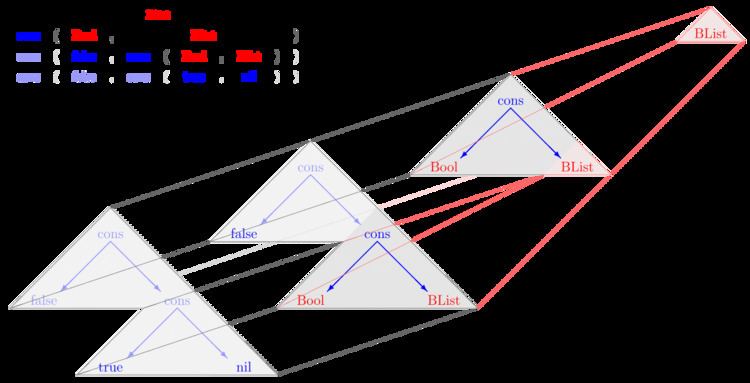 | ||
In theoretical computer science and formal language theory, a regular tree grammar (RTG) is a formal grammar that describes a set of directed trees, or terms. A regular word grammar can be seen as a special kind of regular tree grammar, describing a set of single-path trees.
Contents
Definition
A regular tree grammar G is defined by the tuple
G = (N, Σ, Z, P),
where
Derivation of trees
The grammar G implicitly defines a set of trees: any tree that can be derived from Z using the rule set P is said to be described by G. This set of trees is known as the language of G. More formally, the relation ⇒G on the set TΣ(N) is defined as follows:
A tree t1∈ TΣ(N) can be derived in a single step into a tree t2 ∈ TΣ(N) (in short: t1 ⇒G t2), if there is a context S and a production (A→t) ∈ P such that:
Here, a context means a tree with exactly one hole in it; if S is such a context, S[t] denotes the result of filling the tree t into the hole of S.
The tree language generated by G is the language L(G) = { t ∈ TΣ | Z ⇒G* t }.
Here, TΣ denotes the set of all trees composed from symbols of Σ, while ⇒G* denotes successive applications of ⇒G.
A language generated by some regular tree grammar is called a regular tree language.
Examples
Let G1 = (N1,Σ1,Z1,P1), where
An example derivation from the grammar G1 is
BList ⇒ cons(Bool,BList) ⇒ cons(false,cons(Bool,BList)) ⇒ cons(false,cons(true,nil)).
The image shows the corresponding derivation tree; it is a tree of trees (main picture), whereas a derivation tree in word grammars is a tree of strings (upper left table).
The tree language generated by G1 is the set of all finite lists of boolean values, that is, L(G1) happens to equal TΣ1. The grammar G1 corresponds to the algebraic data type declarations (in the Standard ML programming language):
Every member of L(G1) corresponds to a Standard-ML value of type BList.
For another example, let G2 = (N1,Σ1,BList1,P1 ∪ P2), using the nonterminal set and the alphabet from above, but extending the production set by P2, consisting of the following productions:
The language L(G2) is the set of all finite lists of boolean values that contain true at least once. The set L(G2) has no datatype counterpart in Standard ML, nor in any other functional language. It is a proper subset of L(G1). The above example term happens to be in L(G2), too, as the following derivation shows:
BList1 ⇒ cons(false,BList1) ⇒ cons(false,cons(true,BList)) ⇒ cons(false,cons(true,nil)).
Language properties
If L1, L2 both are regular tree languages, then the tree sets L1 ∩ L2, L1 ∪ L2, and L1 \ L2 are also regular tree languages, and it is decidable whether L1 ⊆ L2, and whether L1 = L2.
Alternative characterizations and relation to other formal languages
Rajeev Alur and Parthasarathy Madhusudan related a subclass of regular binary tree languages to nested words and visibly pushdown languages.
The regular tree languages are also the languages recognized by bottom-up tree automata and nondeterministic top-down tree automata.
Regular tree grammars are a generalization of regular word grammars.
Applications
Applications of regular tree grammars include:
